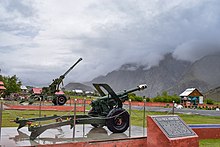| Revision as of 05:04, 8 September 2020 editRMCD bot (talk | contribs)Bots, Template editors999,826 edits Notifying subject page of move discussion on Talk:Dras War MemorialTag: Reverted← Previous edit | Revision as of 18:14, 23 September 2020 edit undoStraussInTheHouse (talk | contribs)Autopatrolled, Extended confirmed users, File movers, Pending changes reviewers, Rollbackers35,921 editsm StraussInTheHouse moved page Dras War Memorial to Kargil War Memorial without leaving a redirect: Requested move, see Talk:Kargil War Memorial.Tag: RevertedNext edit → |
| (No difference) | |
Revision as of 18:14, 23 September 2020
| A request that this article title be changed to Kargil War Memorial is under discussion. Please do not move this article until the discussion is closed. |
| This article includes a list of general references, but it lacks sufficient corresponding inline citations. Please help to improve this article by introducing more precise citations. (February 2020) (Learn how and when to remove this message) |


The Kargil War Memorial, also known as Dras War Memorial, is a war memorial built by the Indian Army in the town of Dras, commemorating the 1999 Kargil War between India and Pakistan. The memorial is located on the Srinagar-Leh National Highway 1D, about 5 km from the city centre across the Tiger Hill.
History
In the winter of 1998-1999, the Pakistani Army crossed the Line of Control (LoC) and occupied numerous heights dominating the National Highway and roads connecting Leh (Ladakh) and Kargil to Shrinagar. The Indian Army launched Operation Vijay ("Victory") in May 1999 to retake the territory, leading to fierce battles in the harsh mountain environment. Each year, 26 July is observed as Kargil Vijay Diwas (Kargil Victory Day), during which the Prime Minister of India pays tribute to the soldiers at Amar Jawan Jyothi at the India Gate, New Delhi.
A makeshift memorial is said to have been constructed at the site to honor Indian troops in 2000. The memorial in its present form was constructed by the Indian Army in November 2014.
Design
The central feature of the memorial is a pink sandstone wall bearing a brass plate engraved with names of the soldiers who died during Operation Vijay. Visible from the site are the Tololing Heights, Tiger Hill, and Point 4875 (Batra Top), where fighting took place during the conflict.
The memorial features the Captain Manoj Pandey gallery, which commemorates a young officer who was posthumously awarded the Param Vir Chakra, India's highest military award, for leadership during the war.
Over the years, several infrastructural improvements have been made to the site. On 26 July 2012, the Flag Foundation of India presented too the memorial a giant national flag measuring 11.4 by 7.6 metres (37+1⁄2 by 25 ft) and weighing 15 kg, on a 30-metre (100 ft) flag pole. The Dras War Memorial is now an important landmark and a major tourist attraction in Western Ladakh—in the year 2016, it received about 1,25,000 visitors.

References
- "Drass memorial: Invoking memories of Kargil war". Rediff. 27 July 2011.
- ^ "Dras War Memorial - Vijaypath". jktourism.org.
- "Kargil War Memorial". jktourism.org.
34°26′00″N 75°48′21″E / 34.4332369°N 75.8058092°E / 34.4332369; 75.8058092
External links
 Media related to Kargil War Memorial at Wikimedia Commons
Media related to Kargil War Memorial at Wikimedia Commons- Kargil War Memorial - Honouring our War Heroes